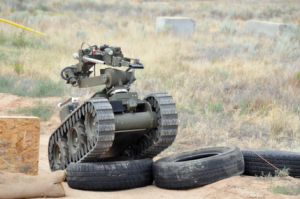DARPA’s Urban Challenge – the third – was held last weekend; what’s DARPA’s Urban Challenge?
The DARPA Urban Challenge is an autonomous vehicle research and development program with the goal of developing technology that will keep warfighters off the battlefield and out of harm’s way. The Urban Challenge features autonomous ground vehicles maneuvering in a mock city environment, executing simulated military supply missions while merging into moving traffic, navigating traffic circles, negotiating busy intersections, and avoiding obstacles.
The program is conducted as a series of qualification steps leading to a competitive final event, scheduled to take place on November 3, 2007, in Victorville, California. DARPA is offering $2M for the fastest qualifying vehicle, and $1M and $500,000 for second and third place.
– snip –
What is an autonomous ground vehicle?
An autonomous ground vehicle is a vehicle that navigates and drives entirely on its own with no human driver and no remote control. Through the use of various sensors and positioning systems, the vehicle determines all the characteristics of its environment required to enable it to carry out the task it has been assigned.
Why develop autonomous vehicles?
The National Defense Authorization Act for Fiscal Year 2001, Public Law 106-398, Congress mandated in Section 220 that “It shall be a goal of the Armed Forces to achieve the fielding of unmanned, remotely controlled technology such that… by 2015, one-third of the operational ground combat vehicles are unmanned.” DARPA conducts the Urban Challenge program in support of this Congressional mandate. Every “dull, dirty, or dangerous” task that can be carried out using a machine instead of a human protects our warfighters and allows valuable human resources to be used more effectively.
Who are the teams?
The Urban Challenge teams come from across the United States and around the world, and share a passion for the advancement of robotic technology and machine intelligence. This diverse group includes teams from both academia and the robotics, automotive, and defense industries.
(It should be noted that at least some of these machines probably drive better than a substantial number of people who live in Brooklyn).
I’m sure that lots of good stuff will come out this DARPA project. But it’s interesting to watch Congress asserting itself with a demanding deadline in this project – we’re not hearing about Representatives and Senators banging their hands on hearing-room tables – demanding 100 mpg vehicles, better insulating materials, or field-deployable energy systems that will reduce the horrible risks associated with sending convoys out to pick up a truckload diesel.
The Urban Challenge main page;
John Markoff’s excellent piece in yesterday’sTimes. Markoff has been covering this process since at least 1984. In my less-than-methodical view of my hometown paper, Markoff’s byline means it’s going to be interesting – and often well ahead of the pack.
Here’s a Times
page with links to all of his recent work.
http://www.darpa.mil/grandchallenge/teamlist.asp.


